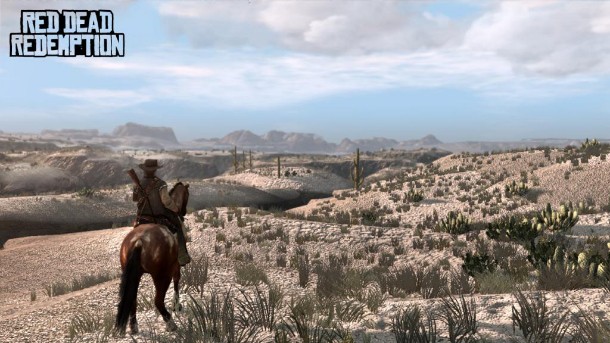Please support Game Informer. Print magazine subscriptions are less than $2 per issue
Exploring Freedom In Red Dead Redemption

As part of of our day-long examination of the concept of freedom in video games, I wrote this essay about Rockstar Games’ Red Dead Redemption:
Perhaps no game is more closely tied to the mythology of American freedom than Red Dead Redemption – a game set in the “Wild West,” a short period of time from the middle to the end of the 19th century. This era of outlaws, cowboys, and quick-shooting marshalls didn’t last long – and, it’s fair to say, was always at least partly fiction – but it’s proven to be rich subject matter for literature and film over the years. From Stagecoach to Django Unchained, westerns have been a staple of Hollywood since the beginning of moving pictures, but were largely untapped in video games. I’ve never quite understood why. My two pet theories: 1) developers thought today’s “hip” teens wouldn’t embrace the western. 2) it’s really hard to perfect realistic horse-riding animation and physics.
Rockstar Games blew both these theories out of the water in 2010 with the release of Red Dead Redemption. There are many reasons for the game’s success: a novel (for video games) setting, the great writing, a memorable main character in John Marston, and Rockstar’s usual flair for creating engaging open-world gaming experiences.
Now, in some ways, all “freedom” in video games is an illusion (some might say its an illusion outside of games, too, but that’s a philosophical discussion for another day). You’re offered as much freedom as is allowed you by the creators. Recently, games like Minecraft have offered near-total freedom, but they are also free of the constraints of story, objectives, and the progress in the conventional sense. For most games, there is freedom in between the moments and win conditions that must happen to allow you to keep playing. Rockstar’s genius has been an ability to stretch out these moments, and provide just enough structure and motivation to side activities to make them as compelling as the “proper” missions. Despite the fact that Red Dead and the GTA games are largely a linear sequence of single-player missions, giving you the ability to tackle them at your own pace or giving you the option of choosing a mission from a small selection of alternatives makes these experience feel more “free” than they really are.
If this sounds like criticism, it’s not. Video games are about creating illusions, and Rockstar makes the best open-world games because they know how to create a sense of freedom even in a highly structured experience. I don’t know if the company ever did this better than in Red Dead Redemption. There were so many great side activities, from action-oriented objectives like bounty hunting and train robberies to smaller-scale fun like Liar’s Dice and horse breaking. For me, and many others, hunting became a game in itself – I doubt Rockstar would have guessed its players would spend so much time sniping birds and bunnies. Throw in a wealth of optional side missions you’d encounter on your travels, and you’ve got a game that felt like a world unto itself, populated with odd characters and places to discover.
Though the games are nearly identical in structure, I never felt as free in a Grand Theft Auto game as I did in Red Dead Redemption. I think this is a matter of simple aesthetics; there’s something about the wide-open spaces of the American southwest resonates with me in a way that an urban environment just can’t. My favorite moments playing Red Dead Redemption weren’t technically “gameplay” at all – just watching the sun rise over a hill in the distance, taking a moment to appreciate the game’s gorgeous environments and quiet beauty. Having the time to appreciate the beauty around you, maybe that’s true freedom.










